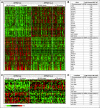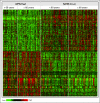Favorable prognostic impact of NPM1 mutations in older patients with cytogenetically normal de novo acute myeloid leukemia and associated gene- and microRNA-expression signatures: a Cancer and Leukemia Group B study
- PMID: 20026798
- PMCID: PMC2815994
- DOI: 10.1200/JCO.2009.25.1496
Favorable prognostic impact of NPM1 mutations in older patients with cytogenetically normal de novo acute myeloid leukemia and associated gene- and microRNA-expression signatures: a Cancer and Leukemia Group B study
Abstract
Purpose: To analyze the prognostic significance of NPM1 mutations, and the associated gene- and microRNA-expression signatures in older patients with de novo, cytogenetically normal acute myeloid leukemia (CN-AML) treated with intensive chemotherapy.
Patients and methods: One hundred forty-eight adults age >or= 60 years with de novo CN-AML, enrolled onto Cancer and Leukemia Group B protocols 9720 and 10201, were studied at diagnosis for NPM1, FLT3, CEBPA, and WT1 mutations, and gene- and microRNA-expression profiles.
Results: Patients with NPM1 mutations (56%) had higher complete remission (CR) rates (84% v 48%; P < .001) and longer disease-free survival (DFS; P = .047; 3-year rates, 23% v 10%) and overall survival (OS; P < .001; 3-year rates, 35% v 8%) than NPM1 wild-type patients. In multivariable analyses, NPM1 mutations remained independent predictors for higher CR rates (P < .001) and longer DFS (P = .004) and OS (P < .001), after adjustment for other prognostic clinical and molecular variables. Unexpectedly, the prognostic impact of NPM1 mutations was mainly observed in patients >or= 70 years. Gene- and microRNA-expression profiles associated with NPM1 mutations were similar across older patient age groups and similar to those in younger (< 60 years) patients with CN-AML. These profiles were characterized by upregulation of HOX genes and their embedded microRNAs and downregulation of the prognostically adverse MN1, BAALC, and ERG genes.
Conclusion: NPM1 mutations have favorable prognostic impact in older patients with CN-AML, especially those age >or= 70 years. The gene- and microRNA-expression profiles suggest that NPM1 mutations constitute a marker defining a biologically homogeneous entity in CN-AML that might be treated with specific and/or targeted therapies across age groups.
Conflict of interest statement
Authors' disclosures of potential conflicts of interest and author contributions are found at the end of this article.
Figures



Similar articles
-
Prognostic significance of, and gene and microRNA expression signatures associated with, CEBPA mutations in cytogenetically normal acute myeloid leukemia with high-risk molecular features: a Cancer and Leukemia Group B Study.J Clin Oncol. 2008 Nov 1;26(31):5078-87. doi: 10.1200/JCO.2008.17.5554. Epub 2008 Sep 22. J Clin Oncol. 2008. PMID: 18809607 Free PMC article.
-
Prognostic importance of MN1 transcript levels, and biologic insights from MN1-associated gene and microRNA expression signatures in cytogenetically normal acute myeloid leukemia: a cancer and leukemia group B study.J Clin Oncol. 2009 Jul 1;27(19):3198-204. doi: 10.1200/JCO.2008.20.6110. Epub 2009 May 18. J Clin Oncol. 2009. PMID: 19451432 Free PMC article.
-
Acute myeloid leukemia with biallelic CEBPA gene mutations and normal karyotype represents a distinct genetic entity associated with a favorable clinical outcome.J Clin Oncol. 2010 Feb 1;28(4):570-7. doi: 10.1200/JCO.2008.21.6010. Epub 2009 Dec 28. J Clin Oncol. 2010. PMID: 20038735
-
Prognostic significance of FLT3 internal tandem duplication, nucleophosmin 1, and CEBPA gene mutations for acute myeloid leukemia patients with normal karyotype and younger than 60 years: a systematic review and meta-analysis.Ann Hematol. 2014 Aug;93(8):1279-86. doi: 10.1007/s00277-014-2072-6. Epub 2014 May 7. Ann Hematol. 2014. PMID: 24801015
-
Prognostically important molecular markers in cytogenetically normal acute myeloid leukemia.Am J Med Sci. 2011 May;341(5):404-8. doi: 10.1097/MAJ.0b013e318201109d. Am J Med Sci. 2011. PMID: 21522052 Free PMC article. Review.
Cited by
-
Identification of Survival-Related Genes in Acute Myeloid Leukemia (AML) Based on Cytogenetically Normal AML Samples Using Weighted Gene Coexpression Network Analysis.Dis Markers. 2022 Sep 29;2022:5423694. doi: 10.1155/2022/5423694. eCollection 2022. Dis Markers. 2022. PMID: 36212177 Free PMC article.
-
A stem cell-like gene expression signature associates with inferior outcomes and a distinct microRNA expression profile in adults with primary cytogenetically normal acute myeloid leukemia.Leukemia. 2013 Oct;27(10):2023-31. doi: 10.1038/leu.2013.181. Epub 2013 Jun 14. Leukemia. 2013. PMID: 23765227 Free PMC article.
-
High expression of inositol 1,4,5-trisphosphate receptor, type 2 (ITPR2) as a novel biomarker for worse prognosis in cytogenetically normal acute myeloid leukemia.Oncotarget. 2015 Mar 10;6(7):5299-309. doi: 10.18632/oncotarget.3024. Oncotarget. 2015. PMID: 25779662 Free PMC article.
-
AML risk stratification models utilizing ELN-2017 guidelines and additional prognostic factors: a SWOG report.Biomark Res. 2020 Aug 12;8:29. doi: 10.1186/s40364-020-00208-1. eCollection 2020. Biomark Res. 2020. PMID: 32817791 Free PMC article.
-
Molecular and alternative methods for diagnosis of acute myeloid leukemia with mutated NPM1: flexibility may help.Haematologica. 2010 Apr;95(4):529-34. doi: 10.3324/haematol.2009.017822. Haematologica. 2010. PMID: 20378574 Free PMC article. No abstract available.
References
-
- Ries LAG, Melbert D, Krapcho M, et al. Bethesda, MD: National Cancer Institute; 2008. SEER Cancer Statistics Review, 1975-2005. http://seer.cancer.gov/csr/1975_2005.
-
- Leith CP, Kopecky KJ, Godwin J, et al. Acute myeloid leukemia in the elderly: Assessment of multidrug resistance (MDR1) and cytogenetics distinguishes biologic subgroups with remarkably distinct responses to standard chemotherapy. A Southwest Oncology Group study. Blood. 1997;89:3323–3329. - PubMed
-
- Fröhling S, Schlenk RF, Kayser S, et al. Cytogenetics and age are major determinants of outcome in intensively treated acute myeloid leukemia patients older than 60 years: Results from AMLSG trial AML HD98-B. Blood. 2006;108:3280–3288. - PubMed
-
- Kantarjian H, O'Brien S, Cortes J, et al. Results of intensive chemotherapy in 998 patients age 65 years or older with acute myeloid leukemia or high-risk myelodysplastic syndrome: Predictive prognostic models for outcome. Cancer. 2006;106:1090–1098. - PubMed
Publication types
MeSH terms
Substances
Grants and funding
- CA33601/CA/NCI NIH HHS/United States
- U10 CA033601/CA/NCI NIH HHS/United States
- U24 CA114725/CA/NCI NIH HHS/United States
- U10 CA101140/CA/NCI NIH HHS/United States
- P30 CA016058/CA/NCI NIH HHS/United States
- CA77658/CA/NCI NIH HHS/United States
- CA31946/CA/NCI NIH HHS/United States
- CA16058/CA/NCI NIH HHS/United States
- CA101140/CA/NCI NIH HHS/United States
- U10 CA077658/CA/NCI NIH HHS/United States
- U10 CA031946/CA/NCI NIH HHS/United States
- R21 CA129657/CA/NCI NIH HHS/United States
- CA129657/CA/NCI NIH HHS/United States
- CA114725/CA/NCI NIH HHS/United States
LinkOut - more resources
Full Text Sources
Other Literature Sources
Medical
Miscellaneous

